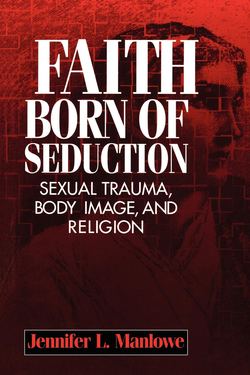Faith Born of Seduction

Реклама. ООО «ЛитРес», ИНН: 7719571260.
Оглавление
Jennifer L Manlowe. Faith Born of Seduction
About NYU Press
FAITH BORN OF SEDUCTION
Contents
Acknowledgments
Introduction
1. Who Are We?
Definitions. Patriarchy
Paternalism
Incest
Eating Disorders
Trauma
Recovery
Sexual Abuse, Faith, and Eating Problems Matched
2. A Horror beyond Tears: Reflections on a History of Abuse
Historical Origins of Trauma
Shared Themes
Early Onset of Abuse
“In your memory, when did the abuse start?”
Broken Trust—Felt Powerlessness
“Regarding your abuse, any idea whether anyone else knew about it?”
Identity Confusion/Divided Selves
“How did you cope with these experiences during and after the abuse?”
Multiple Personality Disorder
Borderline Personality Disorder
Broken Narrative
Recurring Trauma “How did the abuse affect you even when it wasn’t happening in the moment?”
Isolation/Suicidality “How did you feel carrying around this secret of being abused by a trusted family member?”
Self-Injury
“Have you ever abused yourself as a result of being abused? “
Re-offended Later in Life
“Were you ever abused later in life?”
3. A Pyrrhic Victory: Contemplating the Physical Cost of Surviving. Eating Disorders and Incest
Post-Trauma Manifested along Gender Lines
Shared Traumatic Themes Manifested in Eating Disorders. Shame
Guilt
Self-Blame
Society-Blames-the- Victim
Legacy of Repression—The False Self
Damaged Goods
Powerlessness
Solitary Source of Nurture
Undesirability as Vehicle of Protection
4. Disenchanting Faith and the Female Body: Deconstructing Misogynous Themes in Christian Discourse
I. Misogynous Christian Themes. Christian Goodness
The Ultimate Crime: Religiously Licensed Sexual Abuse
Qualification
The Value of Suffering and Self-Sacrifice
Virtue of Repentance and Forgiveness
Female Worth through Purity/Virginity
Need for Redemption
Value of Obedience
II. No Redemption. The Sin of Being Embodied as Female
Origins of a Cultural Illness
When There Is No Outside: Resistance through the Body
Religion and Eating Disorders
Survivors of Violence Seek Radical Purity
5. A Thinly Veiled Skein: Exploring Troublesome Connections among Incest, Eating Disorders, and Religious Discourse
I. Shared Religious Themes. God’s Will
Prayers for Reparation
God’s Silence
Hunger as Indicator of Innate Badness
Parental Projection as God Image
Self-Blame
Crave Sense-Experience of Relief
Food Rituals Symbolic of Spiritual Quest
II. Alternative Coping Techniques. Nugget Experience
What or who facilitated your survival?
Memory of Resistance
Seeking Justice
Role of “Right-Relation”
Courage to See
6. Self-Help or Self-Harm? Analyzing the “Politics” of Twelve-Step Groups for Recovery
A Community of Peers
What’s Going On?
Goals of Rituals for Survivors
How Rituals Work
How Twelve-Step Groups Help. A Place to Share Feelings
Spiritual Strength
Social Skills and Support
Exploring Incest and a Wounded Sexuality Haddock told me the following:
How Twelve-Step Groups Hinder. Individual Disease/Individual Cure
Distrust of the Demonic Ego
Loyalty and Unity
Blames the Victim
Diet Mentality Maintained
Abuse of Power
Unsafe Open Policy
Too Much God-Talk
Paternalism Unchecked
Self-Blaming
What Can the Church Do?
Natalie sees it this way:
Politically Empowering Spirituality
Counsel to Counselors
7. Summary of Key Findings
What Do You Want the Readers to Know?
Appendix A. Sample Questionnaire (Voices)1
The God/Goddess/Higher Power Questionnaire
The “Family” Questionnaire
For Adults Sexually Abused as Children
Appendix B. Research Protocol for Interview Study: “Incest, Eating Disorders, and Religious Self-Descriptions” I General Historical Frame
II Abuse History
III Religious Self-Descriptions
Appendix C. The Twelve Steps of Alcoholics Anonymous
Appendix D. Brief History of Twelve-Step Groups
Appendix E. The Feminist Steps
Appendix F. Profile of Male Perpetrators1
Type I: Sexually Preoccupied
Type 1 Subcategory: Early sexualizers
Type 2: Adolescent Regressives
Type 3: Instrumental Self-Gratifiers
Type 4: Emotionally Dependent
Type 5: Angry Retaliators
Other Findings
Profile of Female Perpetrators2
Appendix G. Incest Laws1. Criminal Prosecution
Penalties for Incest
Civil Remedies
Appendix H. Letter to Politician1
Appendix I. The Quality of Experience: A Feminist Method
The Interview
Demographics of the Women in the Study. Birthplace
Religion
Education
Employment
Class
Race
Sexual Orientation
Family Information
Offenders
Feminist Qualitative Methodology
Politics of Social Scientific Research
Method of Case Presentation
Anonymity
Nonhygienic Research
Disciplined Subjectivity
Specifics of Long-Interview Method
Self-Interview
Questionnaire
Analytic Categories
Quality Control
Notes. Notes to the Introduction
Notes to Chapter 1
Notes to Chapter 2
Notes to Chapter 3
Notes to Chapter 4
Notes to Chapter 5
Notes to Chapter 6
Notes to Chapter 7
Notes to Appendix A
Notes to Appendix D
Notes to Appendix F
Notes to Appendix G
Notes to Appendix H
Notes to Appendix I
Selected Bibliography
Index
Отрывок из книги
Thank you for buying this ebook, published by NYU Press.
Sign up for our e-newsletters to receive information about forthcoming books, special discounts, and more!
.....
Janine remembers the time she told her mother she was “splitting in half, I mean it . . . right down the middle.” Janine recalls her mother’s response, “Oh honey, all young kids feel that way during adolescence.” It is as if Janine’s mother knew firsthand what her daughter was talking about and yet could not validate her daughter’s experience, possibly to avoid being threatened by her own memories of abuse. Janine posits her divided self at that time, “I think at that point I was truly living a double existence. On the outside I was this friendly cheerleader-type who was always smiling and affirming everybody, and on the inside I vacillated between crying for help and wanting to die.”
One label for this dynamic is called vertical splitting.50 It is thought to be a common response among incest survivors. Currently it is well recognized as a coping mechanism by many clinicians. Dissociating serves many purposes. It provides a way out of the intolerable and psychologically incongruous situation (double-bind), it erects memory barriers (amnesia) to keep painful events and memories out of awareness, it functions as an analgesic to prevent feeling pain, it allows an escape from experiencing guilt, it may even serve as a hypnotic negation of the sense of self.51
.....